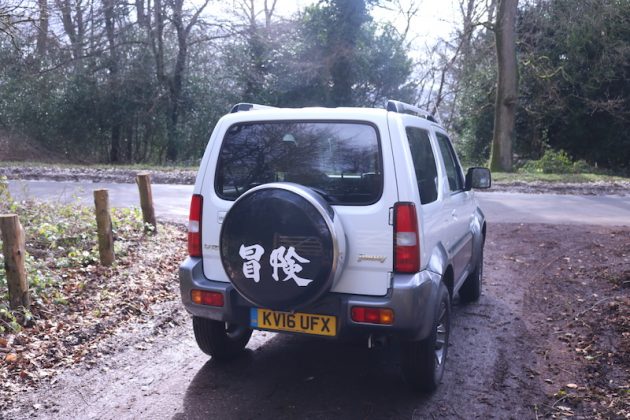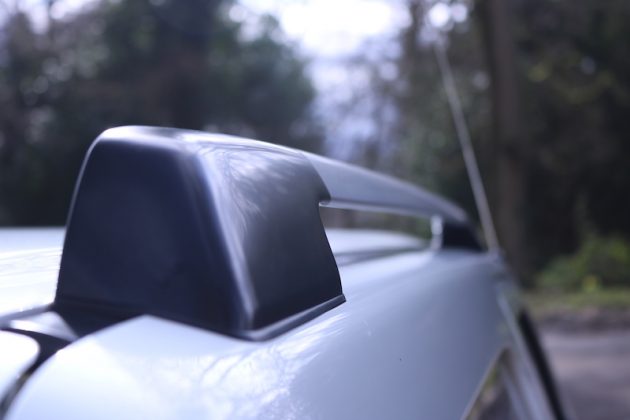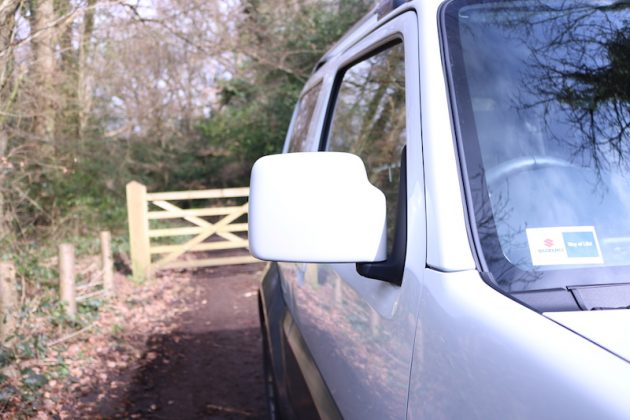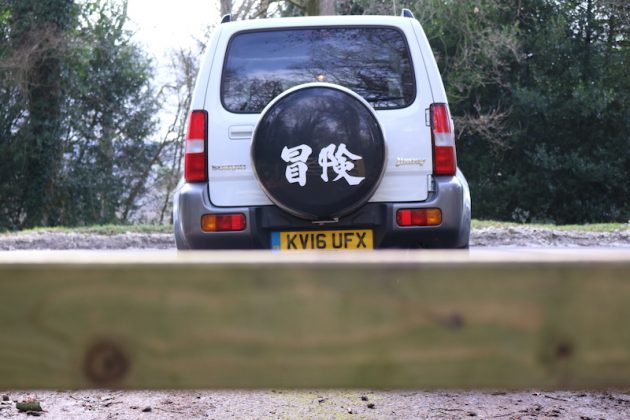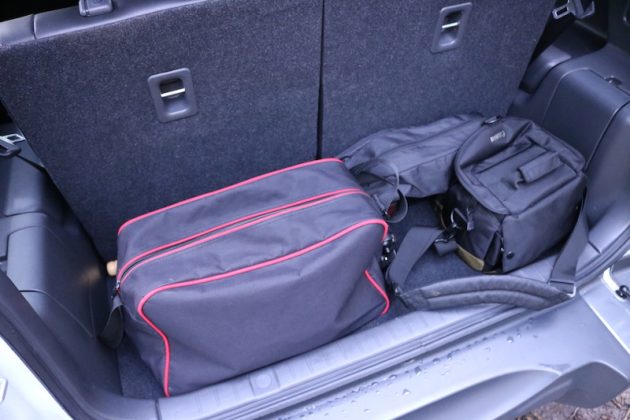Ah, 1998. The time of awful pop music, mobile phones with tiny screens and portable CD players. That feels like a rather long time ago, in fact it’s almost 20 years ago. Blimey. Why do I mention this? This was the year that the current generation of the Jimny arrived on the new car market and it’s hung around defiantly ever since. Buyers demand fancy and sophisticated SUVs nowadays, so is there still a place for the honest and humble Jimny?
Design And Styling
This model may only be a year old but it’s virtually identical to the model first introduced in the late 90s. This means you’re still presented with the friendly and quirky face with no frills such as LED lights. Think of it as an old loyal sheepdog in that regard. One thing that is different though is the two paintwork which helps to give the Jimny further character. The reason for this white/grey colour combo is because this model is the limited Adventure model of which just 200 were produced.
This limited edition package also includes a special hard wheel cover finished in black with the word ‘Adventure’ written upon it in Japanese. Other than that though, the Jimny is fairly basic at the best of times. The top features the obligatory roof rails and inside you will be greeted with leather seats and a cabin which is best described as ‘nostalgic’. It should prove to be durable though, which is exactly what you want from a car like this.
 (3 / 5)
(3 / 5)
Equipment
The Jimny isn’t exactly the best car in regards to equipment, especially if you opt for the base model SZ3. Unless you’re really on a budget, you’ll want to opt for the SZ4 model on which the Adventure edition is based on. This means you’ll get features such as air conditioning, CD player and electric windows. The Adventure spec adds to this with a touchscreen which looks like it came from Halfords, which is home to a DAB radio, satellite navigation and Bluetooth.
The touchscreen works well enough though and it’s easy to use, but it’s not the most enjoyable to use. The sat nav was easy to programme though and it worked fine – albeit a tad slow. In regards to the Bluetooth, it was easy to pair my phone but for some reason I couldn’t play music through. That’s probably just as well really as the two-speaker system is not what you call gutsy. It offers about the same level of bass as a young girl’s voice in fact.
The car is cheap, with prices starting at under £14,300 – the Adventure was priced at £14,949 – but the Dacia Duster is cheaper still, with prices starting from under £10,000. The Duster can seat three in the back and it has a bigger boot, plus it’s more civilised to drive, so the Jimny has tough competition there.
 (2 / 5)
(2 / 5)
Space And Comfort
I’m afraid this is another area where the Jimny Adventure doesn’t fare well. The leather seats look inviting to begin with but they lack the support needed for long journeys and you’re likely to get backache. Mind you that will be after you get a headache, but I’ll come on to that later. A comfortable driving position will be hard to find though as the steering wheel does not adjust at all and the front seats barely adjust.
There are two seats and although they offer a very good level of headroom because of car’s boxy nature, many will want more legroom. The rear is rather cosy too and getting there in the first place isn’t the easiest thanks to the Jimny’s three door nature. In all honesty though you will probably need those rear seats folded if you carry a lot of cargo as the ‘boot’ offers just 113 litres. Access to it could be tricky as the rear door opens sideways, which means the car cannot be parked in tight spaces or with the rear facing a wall.
 (2 / 5)
(2 / 5)
What’s It Like To Drive?
No matter which Jimny model you choose, you will be presented with a 1.3 litre naturally aspirated petrol unit. It’s far from strong, but at least it hasn’t got a lot of weight to carry about as the compact Jimny weighs just 1090kg. That’s not much more than a Mazda MX-5, which I think is pretty astonishing. The engine can be mated to either a 5-speed manual or an automatic, although the former is deemed as the better option.
The ride is bouncy and mostly unsettled so it’s not the most comfortable car to drive. It’s not much better in the corners, so don’t expect a dynamic drive. Don’t expect much performance either as the 1.3 unit offers a grand total of 84bhp. This means 0-60 will come eventually and it will rev loudly to a top speed of just 87mph. But that’s just fine. This is because anything above 50 is likely to give you a headache due to the loud engine note and the high wind noise.

The wind will present another problem as well. As mentioned the Jimny is light, but because of its flat, boxy nature it means it’s susceptible to moving with a crosswind. I drove this on the QE2 bridge in dark, wet and windy conditions and it was genuinely one of the scariest things I’ve done in a car. However, I need to be fair here, the Jimny was not really designed for long distance journeys. It’s better on the mud than it is the blacktop.
So with that in mind, let’s cover what the Jimny is like off-road. The test model provided by Suzuki came with road tyres so I was keen to see how it would do when the going get muddy. Naturally, the Jimny has four-wheel drive, but it also has a low-range gearbox, which is what any proper off-road model should have. Despite it’s on-road footwear, the Jimny did very well and I was genuinely surprised with what it could do.
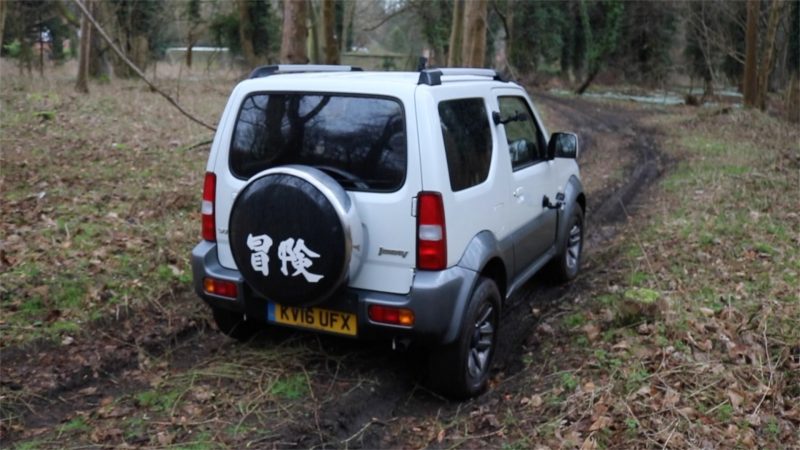
On-road:  (2 / 5)
(2 / 5)
Off-road:  (4 / 5) (based on road tyres)
(4 / 5) (based on road tyres)
Fuel Economy
You’d think that 1.3 litre unit would be rather frugal, but because the lack of a turbo, the engine needs to be worked hard to make progress, so you’ll find the economy will be average at best. 39.8mpg is the official figure offered by Suzuki on a combined journey, which isn’t exactly anything to write home about. Working out the mpg was a tad difficult as the trip computer didn’t offer an mpg reading.

After a bit of basic mathematics, I was able to work out that I had been achieving 31.8mpg, which is not too far of the official figure but it’s far from class-leading and you really feel a diesel engine should be available for better economy. Better torque would be another advantage of a diesel as well. Emissions and road tax aren’t much better as the Jimny produces 165g/km of CO2 with G rated VED Tax band.
 (2 / 5)
(2 / 5)
Verdict
A part of me likes the honest, no-nonsense nature of the Jimny. If you’re looking for a cheap, compact SUV that is dependable off-road then it’s difficult to come up with any alternatives. The only problem is the Dacia Duster is almost £5,000 cheaper and it’s more civilised to drive, without comprising off-road ability. I took a Duster off-road last year and it did just fine.
The Duster is also bigger as well, offering a larger boot and cabin, although I think the Jimny is a better looking car. The Duster can also be specified with a diesel engine so that’s another blow for the Jimny. This then, is a tough car to recommend and although the drive wasn’t overly pleasant, I found the car had a certain charm some how. Sadly though, that’s not enough.
The Jimny may be fantastic off-road, but it’s not enough to make up for its on-road shortcomings. Unless you are desperate for a pint-sized off-roader which is cheap, the Jimny may not be for everyone. A lot has changed since 1998 and it feels like the world has simply passed the Jimny by. Time for a revamp perhaps?
Car Obsession Rating:  (2 / 5)
(2 / 5)
Pros:
- Fantastic off-road
- Good visibility
- Great headroom
- Cheap to buy
Cons:
- Uncomfortable and noisy
- Poor on-road performance
- Small boot
- Cheap, dated interior
- Poor economy
- Weak engine
- Average equipment



















